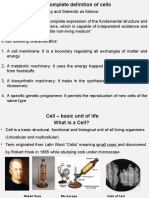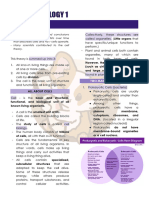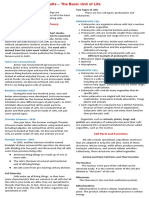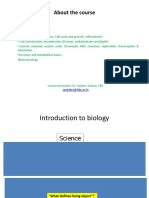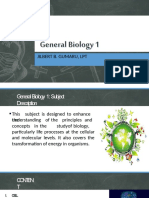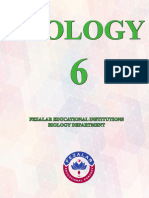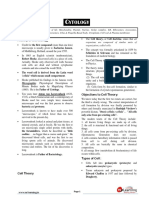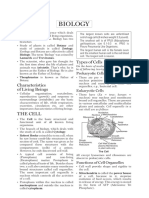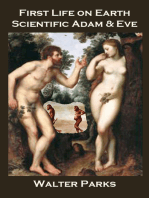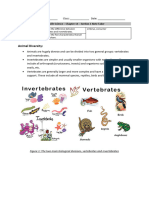Day 20 Main Concepts of Life Sciences: Celle
Day 20 Main Concepts of Life Sciences: Celle
Uploaded by
karthikeyanbose98Copyright:
Available Formats
Day 20 Main Concepts of Life Sciences: Celle
Day 20 Main Concepts of Life Sciences: Celle
Uploaded by
karthikeyanbose98Original Title
Copyright
Available Formats
Share this document
Did you find this document useful?
Is this content inappropriate?
Copyright:
Available Formats
Day 20 Main Concepts of Life Sciences: Celle
Day 20 Main Concepts of Life Sciences: Celle
Uploaded by
karthikeyanbose98Copyright:
Available Formats
Day 20 – Main Concepts Of Life Sciences
2. Botany - Theophrastus
Introduction
• The life sciences or biological sciences comprise the 3. Genetics - Gergor Mendal
branches of science that involve the scientific study of 4. Cytology - Robert Hooke
life and organisms- such as microorganisms, plants, and 5. Zoology - Aristotle
animals including human being.
Cell Biology and Cell Organelles
• Life science is one of the two major branches of natural
science. CELL
• Life sciences focus on a specific type of organism. • The word ‘cell’ comes from the Latin word ‘Celle” which
• For example, Zoology is the study of animals, while means ‘a small compartment’.
Botany is the study of plants. • The word cell was first used by Robert Hooke (1662)In
1660’s Robert Hooke observed something which looks
• Life science discoveries are helpful in improving the
like ‘honeycomb with a great little boxes’ which was
quality and standard of life and have applications in
later called as ‘cell’ from the cork tissue in 1665. He
health agriculture, medicine etc.
compiled his work as Micrographia.
Some important list of life science:
• Robert Brown (1831-39) described the spherical body
1. Bacteriology in the plant cells as nucleus. H. J. Dutrochet (1824), a
2. Virology. French scientist, was the first to give idea Schwann
3. Phycology (German Zoologist) (1833) outlined the basic features of
4. Mycology the cell theory. Rudolf Virchow (1858) explained the
cell theory
5. Cytology
Cell Theory
1.Bacteriology:
In 1833, German botanist Matthias Schleiden and German
• The science and study of bacteria and their relation to
zoologist Theodor Schwann proposed that all plants and
medicine and to other areas such as agriculture.
animals are composed of cells and that cells were the basic
2.Virology: building blocks of life
• Virology is the scientific study of viruses. Types of cells
3.Phycology: On the basis of the cellular organization and the nuclear
• Phycology is the scientific study of algae. characteristics, the cell can be divided into
1. Prokaryotes
4.Mycology:
2. Mesokaryotes and
• Mycology is the study of Fungi.
3. Eukaryotes
5.Cytology:
Prokaryotes
• The study of structure and function of plant and animal
Those organisms with primitive nucleus are called as
cells.
prokaryotes (pro – primitive; karyon – nucleus). The DNA lies in
List of branches of Biology and their Fathers:
the ‘nucleoid’ which is not bound by the nuclear membrane and
1. Biology - Aristotle therefore it is not a true nucleus
www.raceinstitute.in Headquarters: 7305061751 Online Classes: 7550003885 Page | 1
Extreme Circle
Mesokaryotes Cytoplasm
In the year 1966, scientist Dodge and his coworkers proposed Cytoplasm is the main arena of various activities of a cell. It is
another kind of organisms called mesokaryotes. These the semifluid gelatinous substance that fills the cell. It is made
up of eighty percent water and is usually clear and colourless
organisms which shares some of the characters of both
prokaryotes and eukaryotes. • Chloroplast is filled with gelatinous matrix, lipo-
proteinaceous fluid called stroma. Inside the stroma
Eukaryotes
there is flat interconnected sacs called thylakoid
Those organisms which have true nucleus are called Eukaryotes • Grana (singular: Granum) are formed when many of
(Eu – True; karyon – nucleus). The DNA is associated with these thylakoids are stacked together like pile of coins.
protein bound histones forming the chromosomes. Nucleus
Difference between plant and animal cells • Nucleus is an important unit of cell which control all
activities of the cell. Nucleus holds the hereditary
S.
Plant cell Animal Cell information. It is the largest among all cell organelles
No
• The inner membrane is smooth without ribosomes and
Usually they are larger than animal Usually smaller the outer membrane is rough by the presence of
1
cells than plant cells ribosomes
Cell wall present in addition to Cell Organelles
plasma membrane and consists of
2 Cell wall absent
middle lamellae, primary and Golgi Body (Dictyosomes)
secondary walls In 1898, Camillo Golgi visualized a netlike reticulum of fibrils
near the nucleus, were named as Golgi bodies. In plant cells
Plasmodesmata
3 Plasmodesmata present they are found as smaller vesicles termed as dictyosomes
absent
Functions:
Chloroplast
4 Chloroplast present Glycoproteins and glycolipids are produced .Transporting and
absent storing Production of digestive enzymes. Cell plate and cell wall
Vacuole small and formation
5 Vacuole large and permanent
temporary Mitochondria
6 Tonoplast present around vacuole Tonoplast absent • It was first observed by A. Kolliker (1880). Altmann
(1894) named it as Bioplasts. Later Benda (1897, 1898),
Centrioles absent except motile
7 Centrioles present named as mitochondria. They are ovoid, rounded, rod
cells of lower plants shape and pleomorphic structures Mitochondrion
Nucleus present along the Nucleus at the consists of double membrane, the outer and inner
8 membrane.
periphery of the cell centre of the cell
• The inner membrane is convoluted called crista (plural:
Lysosomes
9 Lysosomes are rare cristae). Cristae contain most of the enzymes for
present
electron transport system .Mitochondria are called
Storage material Power house of a cell, as they produce energy rich ATP.
10 Storage material is starch grains is a glycogen Plastids
granules The term plastid is derived from the Greek word Platikas
(formed/moulded) and used by A.F.U. Schimper in 1885
Cell Membrane Chromoplasts Leucoplasts
The cell membrane is also called cell surface (or) plasma (Coloured Plastids) (Colourless Plastids
store food materials)
membrane. It is a thin structure which holds the cytoplasmic
content called ‘cytosol’. Chloroplast Amyloplast – stores –
Occurs in green algae and higher starch
Function of Cell Membrane
plants Pigments chlorophyll a and b
The functions of the cell membrane is enormous which includes
Leucoplast Amyloplast – stores –
cell signaling, transporting nutrients and water, preventing
(Colourless Plastids store food starch
unwanted substances entering into the cell, and so on.
materials)
www.raceinstitute.in Headquarters: 7305061751 Online Classes: 7550003885 Page | 2
Extreme Circle
• Chloroplast is filled with gelatinous matrix, lipo- Flagella
proteinaceous fluid called stroma. Inside the stroma Flagella are helical appendages helps in motility. They are much
there is flat interconnected sacs called thylakoid thinner than flagella or cilia of eukaryotes. The filament
• Grana (singular: Granum) are formed when many of contains a protein called flagellin
these thylakoids are stacked together like pile of coins. Habitat - Various Habitats of Plants
Functions: The living Place of a plant provides food, shelter and suitable
1. Photosynthesis climate to survive and Reproduce successfully. Such a place of
2. Light reactions takes place in granum, living is called a habitat. Plants live in different habitats such as
water, land, desert, hills and so on.
3. Dark reactions take place in stroma,
WARMING (1909) classified the Plants into three types on the
Ribosome
basis of their water requirement. They are
Ribosomes were first observed by George Palade (1953) as
1. Hydrophytes
dense particles or granules in the electron microscope
2. Mesophytes
Types of Ribosomes
3. Xerophytes
• 70S Ribosomes (sub unit 30S and 50S)
1. Hydrophytes:
• 80SRibosomes (sub units 40S and 60S)
Plants which Live in water are called hydrophytes. They are
• Ribosome consists of RNA and protein: RNA 60 % and divided into three types
Protein 40%. During protein synthesis many ribosomes
a) Free-floating hydrophytes
are attached to the single mRNA is called polysomes or
E.g. Water hyacinth (Agayatamarai)
polyribosomes
b) Attached floating hydrophytes
Lysosomes
E.g. Water-lily (alli), Lotus.
• Lysosomes are small vacuoles formed when small
c) Submerged hydrophytes
pieces of golgi body are pinched off from its tubules.
e.g. Vallisneria
• These are known as suicidal bags.
Glyoxysomes
Adaptations of Hydrophytes
Glyoxysome is a single membrane bound organelle. It is a sub
1. Root system is poorly developed. In some cases roots
cellular organellewas discovered by Harry Beevers (1961).
are even absent.
Vacuoles
2. Stem is thick, short and spongy With air spaces to float
• In plant cells vacuoles are large, bounded by a single in water
unit membrane called Tonoplast. The vacuoles contain 3. Leaves have a waxy-coat that prevents their decay in
cell sap, which is a solution of sugars, amino acids, excess water.
mineral salts, waste chemical and anthocyanin
2. Mesophytes:
pigments.
These plants grow in places with Moderate water supply.
• The major function of plant vacuole is to maintain water
E.g. Wheat, maize, sunflower, Mango, neem.
pressure
Adaptations of mesophytes
Chromosomes
1. They have well developed root System.
• ‘Chromosome’ was introduced by Waldeyer in 1888.
2. Leaves are usually large and broad.
Bridges (1916) first proved that chromosomes are the
physical carriers of genes. It is made up of DNA and
associated proteins. 3. Xerophytes:
The Plant body is adapted to cope with the water scarcity, high
• The chromosomes are composed of thread like strands
temperature, Strong winds, etc.
called chromatin which is made up of DNA, protein and
RNA E.g. Opuntia (chappathikalli).
www.raceinstitute.in Headquarters: 7305061751 Online Classes: 7550003885 Page | 3
Extreme Circle
Adaptations of Xerophytes: உயிரியலின் முக்கியக் ககோட்போடுகள்
1. They have long roots which go Deep into the ground so
அறிமுகம்:
as to absorb water.
• அறிவியல் அல்லது உயிரியல் ஸ்கின்ஸ்கள் உயிர் மற்றும்
2. In Opuntia, the stem is thick, flat and green and does
the function of photosynthesis. உயிரினத்தின் வோழ்க்கக விஞ்ஞோன ஆய்கவ
3. Leaves are reduced or modified into spines to prevent உள்ளடக்கிய ஸ்கின்ஸின் கிகளககள உள்ளடக்கியது.
the loss of water from their surface. • இயற்கக அறிவியல் இரண்டு முக்கிய கிகளகளில் ஒன்று
Herbs, Shrubs and Trees வோழ்க்கக அறிவியல்.
Flowering plants can be grouped Based on their size of stem. • வோழ்க்கக அறிவியல் ஒரு குறிப்பிட்ட வகக உயிரினத்தில்
They are herbs, shrubs and trees. கவனம் செலுத்துகிறது எடுத்துக்கோட்டோக, விலங்கியல்
1. Herbs என்பது விலங்குகளின் ஆய்வு, தோவரவியல் என்பது
• Small plants with soft and Green stems are called herbs. தோவரங்களின் ஆய்வு.
• They are non-woody plants and do not grow more than
• வோழ்க்கக அறிவியல் கண்டுபிடிப்புகள் வோழ்க்ககத்
One meter in height.
தரத்கதயும் கமம்படுத்த உதவுகின்றன மற்றும் சுகோதோரம்,
E.g. Radish, wheat, paddy, sunflower
விவெோயம், மருத்துவம் கபோன்றவற்றில் பயன்போடுககளக்
2. Shrubs
சகோண்டுள்ளது
• Medium sized plants
வோழ்க்கக அறிவியலின் சில முக்கியமோன பட்டியல்:
• A thin but hard and woody stem are called shrubs.
1. போக்டீரியோலஜி
• They do not have a clear main stem.
2. கவரோலஜி
• They tend to branch and become Bushy.
• E.g. Rose, jasmine, croton, Tulsi, Lemon. 3. கபக்கோலஜி
Parts of a Plant 4. கமக்கோலஜி
• Roots, Stem, Leaves and Flowers 5. கெட்டோலஜி
Root system: போக்டீரியோலஜி:
1. Tap root system: e.g. Mango, neem, carrot, radish, etc. போக்டீரியோவின் அறிவியல் மற்றும் ஆய்வு மற்றும் அவற்றின்
2. Adventitious root system: e.g. Rice, grass, maize, மருத்துவம் மற்றும் கவளோண்கம கபோன்ற பிற பகுதிகளுக்கோன
bamboo.
சதோடர்பு.
Leaf & Normal functions of leaf:
கவரோலஜி:
1. Synthesis of Food
கவரோலஜி என்பது கவரஸ்களின் ஆய்வு.
2. Exchange of Gases
3. Transpiration
கபக்கோலஜி:
Flower: கபக்கோலஜி என்பது ஆல்கோவின் அறிவியல் ஆய்வு ஆகும்.
Flower is called the reproductive Part of a plant because it helps கமக்கோஜி:
in sexual Reproduction. கமக்கோலஜி என்பது பூஞ்கெ பற்றிய ஆய்வு.
A flower has four part:-
கெட்டோலஜி:
1. Calyx
கெட்கடோலஜி என்பது தோவர மற்றும் விலங்கு உயிரணுக்களின்
2. Corolla
அகமப்பு மற்றும் செயல்போடு பற்றிய ஆய்வு.
3. Androecium - It is the male part of the flower
உயிரியலின் சவவ்கவறு கிகளகளின் பட்டியல் அவர்களின்
4. Gynoecium: It is the female part of a flower
பிதோக்கள்:
Kurinji is a rare flower that blooms once in 12 Years. It is 1. உயிரியல் - அரிஸ்டோட்டில்
endemic (found only) to Tamil Nadu. 2. தோவரவியல் - திகயோபிரட்டஸ்
www.raceinstitute.in Headquarters: 7305061751 Online Classes: 7550003885 Page | 4
You might also like
- Cell TheoryDocument32 pagesCell TheorySumana BasuNo ratings yet
- Knjiga Apstrakta - Book of Abstracts MIKROMED 2018 REGIODocument245 pagesKnjiga Apstrakta - Book of Abstracts MIKROMED 2018 REGIOЛука ЈовановићNo ratings yet
- CHAPTER 1 Microbial World and YouDocument4 pagesCHAPTER 1 Microbial World and YouAsther MantuaNo ratings yet
- Botany ReviewerDocument4 pagesBotany Reviewergoshft99No ratings yet
- Zoology 232 NotesDocument36 pagesZoology 232 NotesKevinNo ratings yet
- Lecture-1-Cell and Cell TheroryDocument13 pagesLecture-1-Cell and Cell Therorytirion7894No ratings yet
- Gen. BioDocument50 pagesGen. BioJohn Russel ValdezNo ratings yet
- Cell TheoryDocument4 pagesCell TheoryemNo ratings yet
- Cell the Unit of LifeDocument26 pagesCell the Unit of LifevetvadivuNo ratings yet
- BiologyDocument52 pagesBiologymounikaemmanuel143No ratings yet
- BIO 111 - Lecture 2Document18 pagesBIO 111 - Lecture 2ddcool009No ratings yet
- 3.1 Reinforcement: Key ConceptDocument1 page3.1 Reinforcement: Key ConceptEyad TalaatNo ratings yet
- Cell - The Unit of LifeDocument29 pagesCell - The Unit of Lifepalsuvra95No ratings yet
- Gen Bio ReviewerDocument4 pagesGen Bio ReviewerDoreen Shane CabigonNo ratings yet
- Gen Bio NotesDocument14 pagesGen Bio NotesZelian ShcwienNo ratings yet
- Gen Bio NTBKDocument7 pagesGen Bio NTBKJillian BautistaNo ratings yet
- Cell, Theory, Structure & FucntionDocument43 pagesCell, Theory, Structure & FucntionJames Paul VelascoNo ratings yet
- Cell - The Unit of LifeDocument29 pagesCell - The Unit of Lifep11925885No ratings yet
- All About CellDocument2 pagesAll About CellCaithlyn KirthleyNo ratings yet
- LESSON 1 CELL Theory Structure and FunctionsDocument7 pagesLESSON 1 CELL Theory Structure and Functionskristinnebondoc68No ratings yet
- Cell BiologyDocument71 pagesCell BiologyShakyra Lei PaballaNo ratings yet
- Science Reviewer MidtermDocument11 pagesScience Reviewer MidtermGenna CuencaNo ratings yet
- Gen Bio 1 Lesson 1234 1Document5 pagesGen Bio 1 Lesson 1234 1wattpadjl97No ratings yet
- About The Course: Topics To Be CoveredDocument25 pagesAbout The Course: Topics To Be CoveredKamal ChoudhuryNo ratings yet
- Development Cell IIDocument19 pagesDevelopment Cell IIyahayarilwanu882No ratings yet
- Lecturer 1 Cells StructureDocument24 pagesLecturer 1 Cells StructureShivangi VermaNo ratings yet
- نظري1 طب حياتيDocument7 pagesنظري1 طب حياتيrppuwwNo ratings yet
- Chapter 1 Cell Biology (5)Document32 pagesChapter 1 Cell Biology (5)lilyabenchaabaneNo ratings yet
- 1st biochemistryDocument37 pages1st biochemistryheen.ahmed.s19No ratings yet
- Cell TheoryDocument5 pagesCell TheoryAdit KumarNo ratings yet
- INTRODUCTION TO CELLS - EditedDocument11 pagesINTRODUCTION TO CELLS - EditedSammel SevillaNo ratings yet
- Origin of Life On EarthDocument47 pagesOrigin of Life On EarthCharismaLeonaEvangelioEnderinaNo ratings yet
- Jilbert B. Gumaru, LPTDocument85 pagesJilbert B. Gumaru, LPTJulius MacaballugNo ratings yet
- CellDocument4 pagesCellanmbeltran31No ratings yet
- GENERAL BIOLOGY 1 Add OnsDocument2 pagesGENERAL BIOLOGY 1 Add Onscrystalmabazza13No ratings yet
- Genbio 1 Q1Document13 pagesGenbio 1 Q1hoseokpogi18No ratings yet
- MODULE 1 - BioDocument4 pagesMODULE 1 - BioSophie BaromanNo ratings yet
- Life and Cell-2014Document65 pagesLife and Cell-2014Yosep Gita ErdinataNo ratings yet
- EED 5 Unit 3Document23 pagesEED 5 Unit 3Lara Mariz FragataNo ratings yet
- Anika Baldizon Dedet - Cell Student Lecture Notes PDFDocument3 pagesAnika Baldizon Dedet - Cell Student Lecture Notes PDFAnika Baldizon DedetNo ratings yet
- Living ThingsDocument29 pagesLiving Thingsfetucchini.009No ratings yet
- Biology 6th Grade (English)Document221 pagesBiology 6th Grade (English)mohaxm1324No ratings yet
- Biology 1Document35 pagesBiology 1alkadafeNo ratings yet
- cell biology chapter 1Document27 pagescell biology chapter 1abdiigobena74No ratings yet
- Chapter-1-Introduction-of-Biology-SCDocument47 pagesChapter-1-Introduction-of-Biology-SCAllen jeffrey Dela cruzNo ratings yet
- Biology NotesDocument39 pagesBiology NotesSTEM-12 Mawac, James Clyde M.No ratings yet
- The Cell Unit of LifeDocument17 pagesThe Cell Unit of LifeRitikNo ratings yet
- Ytology: History of Cell BiologyDocument39 pagesYtology: History of Cell BiologyMonika PatidarNo ratings yet
- Microbial Cell Structure I - Lecture 3Document60 pagesMicrobial Cell Structure I - Lecture 3sanchanavl8205No ratings yet
- Introductiontolifescience 180920034752Document41 pagesIntroductiontolifescience 180920034752Angel AlibangbangNo ratings yet
- Introduction To The Cell and Its StructureDocument6 pagesIntroduction To The Cell and Its StructureMary Ann Leona SelgaNo ratings yet
- 01 Cell TheoryDocument9 pages01 Cell TheoryRay NavarroNo ratings yet
- Cell TheoryDocument70 pagesCell TheoryBeejay.No ratings yet
- Work 3..cell Biology UpdatedDocument47 pagesWork 3..cell Biology UpdatedmuwangasylNo ratings yet
- MC 2 PrelimDocument5 pagesMC 2 PrelimkizzaymenteraNo ratings yet
- Biology and BotanyDocument21 pagesBiology and Botanyrahevarharshvardhan587No ratings yet
- The CellDocument10 pagesThe CellnabasamisamisalahNo ratings yet
- CELLDocument38 pagesCELLТаалай МамбетовNo ratings yet
- Cell Theory and Prokaryotic and Eukaryotic CellDocument4 pagesCell Theory and Prokaryotic and Eukaryotic Cellmj espanolaNo ratings yet
- Lecture+1 Intriduction+to+BiologyDocument50 pagesLecture+1 Intriduction+to+Biologyryzen77700No ratings yet
- Full download Bioinformatics in Rice Research Theories and Techniques 1st Edition Manoj Kumar Gupta (Editor) pdf docxDocument37 pagesFull download Bioinformatics in Rice Research Theories and Techniques 1st Edition Manoj Kumar Gupta (Editor) pdf docxhaisekenziqe100% (4)
- Human Health and Diseases Term II Model Chapter TestDocument4 pagesHuman Health and Diseases Term II Model Chapter TestMitul LovrasNo ratings yet
- Immunology AND Inflammatory: Mr. Bernie Pedrigal Malabanan, RN Lecture SeriesDocument64 pagesImmunology AND Inflammatory: Mr. Bernie Pedrigal Malabanan, RN Lecture SeriesPrincess Naome Calma CantilloNo ratings yet
- Microorganisms and Their Effects On Living Things: Chapter 1 (Form 5)Document28 pagesMicroorganisms and Their Effects On Living Things: Chapter 1 (Form 5)Marzita HamzahNo ratings yet
- Arid Agriculture University Rawalpindi: Pir Mehr Ali ShahDocument6 pagesArid Agriculture University Rawalpindi: Pir Mehr Ali Shahsohaibmuzaffar007100% (1)
- h 046 003271 00 人类免疫缺陷病毒抗原抗体 (Hiv) 测定试剂盒 (Clia) 英文说明书Document14 pagesh 046 003271 00 人类免疫缺陷病毒抗原抗体 (Hiv) 测定试剂盒 (Clia) 英文说明书ltrujilloNo ratings yet
- SY20703 Molecular Cell Biology: (Prof. Madya Dr. Lee Ping Chin, Professor Room 69)Document16 pagesSY20703 Molecular Cell Biology: (Prof. Madya Dr. Lee Ping Chin, Professor Room 69)Charles RajNo ratings yet
- The Frog Scientist Paired Text Lesson Passage - Frogs at RiskDocument3 pagesThe Frog Scientist Paired Text Lesson Passage - Frogs at RiskAbdullah JafarNo ratings yet
- PHD: Host-Parasite InteractionsDocument3 pagesPHD: Host-Parasite InteractionsAlemayehu DargeNo ratings yet
- DLL Science 5Document13 pagesDLL Science 5carylle estelle adap100% (2)
- Unit 2 - Macromolecules Guided Notes - 4th BlockDocument6 pagesUnit 2 - Macromolecules Guided Notes - 4th Blockapi-375285021No ratings yet
- Dissertation Martin Hölzer, 2017 PDFDocument253 pagesDissertation Martin Hölzer, 2017 PDFatpowrNo ratings yet
- Chapter 1 IntroductionDocument26 pagesChapter 1 Introductionkennethchange100No ratings yet
- Bio Eoc Review PacketDocument29 pagesBio Eoc Review Packetapi-267855902No ratings yet
- GR 8 14.1 Note Ans KeyDocument2 pagesGR 8 14.1 Note Ans KeyShaimaa SalamaNo ratings yet
- Unit 1 - Topic 1 - Cell Biology - (11 HL and SL)Document32 pagesUnit 1 - Topic 1 - Cell Biology - (11 HL and SL)John DoeNo ratings yet
- M30 CytoDEATH RocheDocument4 pagesM30 CytoDEATH Rochemars_k2No ratings yet
- PhotosynthesisDocument2 pagesPhotosynthesisalmightyfavouriteNo ratings yet
- Earth and Life Science SHS 15.2 Classical Experiments That Led To The Discovery of First LifeDocument16 pagesEarth and Life Science SHS 15.2 Classical Experiments That Led To The Discovery of First LifeWinsear VardeNo ratings yet
- Laboratory Activity 2 (Meiosis)Document4 pagesLaboratory Activity 2 (Meiosis)Jean V. GetizoNo ratings yet
- Test-8 Bioenergetics (Key) ..Document4 pagesTest-8 Bioenergetics (Key) ..mehar abd0No ratings yet
- What Is A Cell - MedlinePlus GeneticsDocument3 pagesWhat Is A Cell - MedlinePlus Geneticswaqar ahmadNo ratings yet
- Refarat Target Terapi MMDocument57 pagesRefarat Target Terapi MMUmmul HidayahNo ratings yet
- Ginger: Ginger, Slices, Fresh 1.00 TBS (6.00 Grams) Calories: 5 GIDocument6 pagesGinger: Ginger, Slices, Fresh 1.00 TBS (6.00 Grams) Calories: 5 GIMart BrendzNo ratings yet
- PhysioEx Exercise 12 Activity 4Document3 pagesPhysioEx Exercise 12 Activity 4t4gjzhpfjcNo ratings yet
- Forest Resources Ecosystem IGM 2012 Pre-Board ExamDocument19 pagesForest Resources Ecosystem IGM 2012 Pre-Board ExamDear Prudence100% (1)
- 11 Biosynthesis of RNADocument52 pages11 Biosynthesis of RNADayne Ocampo-SolimanNo ratings yet
- Arai, Takaomi - Biology and Ecology of Anguillid Eels-Taylor & Francis (2016)Document334 pagesArai, Takaomi - Biology and Ecology of Anguillid Eels-Taylor & Francis (2016)deryhermawanNo ratings yet
